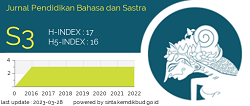Kekerabatan Bahasa Sasak dan Bahasa Mbojo
Abstract
Comparative historical linguistic analysis is an approach in knowing the kinship relationship between one language and another. This study aims to determine the kinship between Sasak and Mbojo languages, by making a comparison between Sasak and Mbojo languages based on 200 Swadesh words. there were four informants used in this study to obtain the data, two speakers of Sasak and Mbojo languages respectively. The research instrument was the researcher herself assisted by a work analysis table listing 200 Swadesh vocabularies. This research is a qualitative-quantitative study using interview techniques in the process of obtaining the data. The results were then analyzed using the Lexicostatistical method, after which they were described. The results of this study indicate that Sasak language and Mbojo language are not only geographically close together, but the two languages are also related to one another with a kinship percentage of 19%. This is evidenced by the similarity of vocabulary in both languages. The Sasak and Mbojo languages are thought to have been a single language in 4256 – 3622 AD. Then the two languages, namely Sasak and Mbojo began to separate from their proton language between 2233 – 1599 AD (calculated in 2023). In Sasak and Mbojo languages, several phonemic correspondences are also found, namely /b/ ~ /w/, /t/ ~ /d/, /ʔ/ ~ /ø/, and /s/ ~ /ø/.
Keywords
Full Text:
PDFReferences
Budasi, I. G. (2007). Kekerabatan Bahasa-bahasa di Sumba:: Suatu kajian linguistik historis komparatif (Doctoral dissertation, Universitas Gadjah Mada).
Fernandes, I.Y. (1996). Relasi Historis Kekerabatan Bahasa Flores: Kajian Linguistik Historis Komparatif Terhadap Sembilan Bahasa di Flores. Ende: Nusa Indah.
Gonzalez, A. (1996). The Philippine experience with the English language: The limits of science in English language teaching. In Castillo, Emma S. (ed.), Alay sa wika: essays in honor of Fe T. Otanes on her 67th birthday, 139–151. Manila: Linguistic Society of the Philippines.
Hakim, L. (2007). Distribusi dan Pemetaan Varian-Varian Bahasa Sasak di Kabupaten Dompu dan Bima. Mabasan, 1(1), 41-61.
Hakim, L. (2008). Kontak Bahasa antara Komunitas Tutur Bahasa Sasak dan Komunitas Tutur Bahasa Mbojo di Kabupaten Dompu dan Bima. Mabasan, 2(2), 64-88.
Hilmi, M. (2017). Leksikostatistik Bahasa (Sasambo) Bahasa Sasak, Bahasa Sumbawa/Samawa, dan Bahasa Bima/Mbojo: Kajian Linguistik Historis Komparatif. Fondatia, 1(1), 165-176.
Hock, H. H. (2009). Principles of historical linguistics. Walter de Gruyter.
Ibrahim, A. S. (1981). Tujuh bahasa Nusantara (sebuah kajian leksikostatistik). Penataran Linguistik Kontrastif dan Historis Komparatif Tahap III, Pusat Pembinaan dan Pengembangan Bahasa, Departemen Pendidikan dan Kebudayaan FKSS IKIP, Malang.
Keraf, G. (1996). Linguistik Bandingan Historis. PT. Gramedia Pustaka Utama .
Keraf, G. (1984). Linguistik bandingan historis. Jakarta: PT. Gramedia
Lailiyah, N., & Wijayanti, F. I. (2022). Kekerabatan Bahasa Jawa, Bali Dan Bima: Perspektif Linguistik Historis Komparatif. Linguistik Indonesia, 40(2), 327-345.
Mbete, A.M. (2002). Metode Linguistik Diakronis. Denpasar: Universitas Udayana.
Setiawan, L. G. I. P. S. (2020). Hubungan Kekerabatan Bahasa Bali dan Sasak dalam Ekoleksikon Kenyiuran: Analisis Linguistik Historis Komparatif. Jurnal Inovasi Penelitian, 1(1), 27-30.
Suparno, P. (2013). Miskonsepsi dan perubahan konsep dalam pendidikan fisika. Edisi, Cet.2. Jakarta : Grasindo.
DOI: https://doi.org/10.17509/bs_jpbsp.v23i2.68686
Refbacks
- There are currently no refbacks.
Copyright (c) 2024 Jurnal Pendidikan Bahasa dan Sastra
p-ISSN 1412-0712 | e-ISSN 2527-8312
JPBS is published by:
Fakultas Pendidikan Bahasa dan Sastra (Faculty of Language and Literature Education), Universitas Pendidikan Indonesia,
in cooperation with
TEFLIN, and APPBIPA


